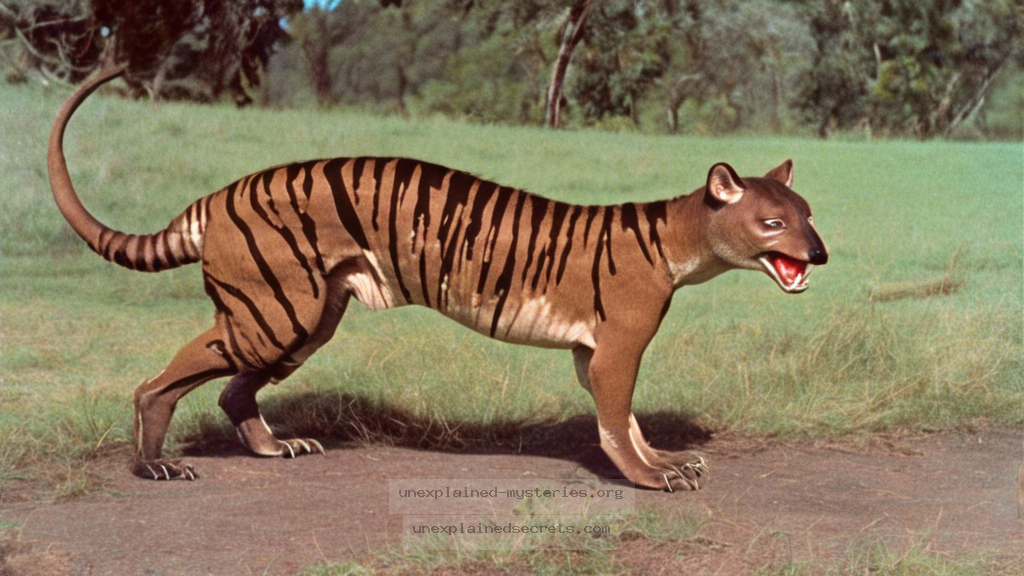What Really Happened During the 1978-79 Tasmanian Tiger Sightings?
What Really Happened During the 1978-79 Tasmanian Tiger Sightings?
The Tasmanian Tiger, or Thylacine, is one of the most compelling mysteries in the realm of cryptozoology. Officially declared extinct in the 1930s, reports of sightings in Tasmania, Australia, during 1978-79 reignited interest in this enigmatic creature. Why do these sightings continue to baffle scientists and enthusiasts alike? This question matters not just because of the Thylacine’s fascinating history, but also because it raises broader questions about extinction, the persistence of cryptids, and humanity’s relationship with the natural world.
Historical Context of the Thylacine
The Thylacine (Thylacinus cynocephalus), once native to Tasmania, Australia, and New Guinea, was a carnivorous marsupial resembling a large dog with distinctive stripes. It was hunted to extinction due to a combination of hunting, habitat destruction, and disease. The last known Thylacine died in captivity in 1936, leading to its classification as extinct by the International Union for Conservation of Nature (IUCN). However, anecdotal evidence and alleged sightings have persisted, particularly after a series of reports in the late 1970s. The cultural impact of the Thylacine extends beyond mere extinction; it touches on themes of loss, conservation, and the unknown.
The 1978-79 Sightings: A Timeline
Between 1978 and 1979, multiple credible sightings of the Thylacine were reported across Tasmania. Notable incidents include:
- February 1978: A motorist spotted a large, striped animal crossing the road near the town of Sheffield.
- April 1978: A group of tourists claimed to have seen what they believed was a Thylacine near the Cradle Mountain area.
- January 1979: A farmer reported a sighting while tending to his livestock, describing the creature’s distinctive features in detail.
These sightings were documented and reported in local newspapers, capturing public interest and leading to further investigations.
Core Concepts: Why Do People Believe in the Thylacine’s Existence?
The persistence of Thylacine sightings can be attributed to several core concepts in cryptozoology:
- Confirmation Bias: Individuals tend to notice and remember events that confirm their beliefs while dismissing those that contradict them.
- Desire for Discovery: The allure of discovering a species thought to be extinct appeals to our innate curiosity and adventurous spirit.
- Environmental Factors: Tasmania’s remote and rugged landscape provides an ideal habitat for elusive creatures, making the possibility of undiscovered species plausible.
This combination of psychological and environmental factors contributes to the ongoing belief in the Thylacine’s existence. Additionally, the emotional connection to the Thylacine as a symbol of lost wildlife fuels passion for its rediscovery.
Evidence and Investigations: What Has Been Found?
The investigations into the Thylacine’s existence include scientific expeditions, photographic evidence, and the analysis of alleged sightings. While no conclusive proof has surfaced, several pieces of evidence are worth noting:
- Photographs: Various blurry images claimed to depict the Thylacine have emerged, though none have been verified as authentic.
- Footprints: In some areas, footprints resembling those of a Thylacine have been found; however, they often lack corroborative evidence.
- Sound Recordings: Some enthusiasts have claimed to capture sounds resembling the Thylacine’s unique vocalizations, but these claims remain unverified.
Alternative Perspectives: Skepticism and Scientific Inquiry
Despite numerous sightings, skepticism remains prevalent among scientists and wildlife experts. Critics argue that the species’ extinction is well-documented, and many sightings could be attributed to misidentification of other animals, such as dogs or wallabies. The Thylacine’s elusive nature makes it challenging to prove or disprove its existence definitively.
Scientific inquiry into the Thylacine’s status has also been limited due to the lack of physical evidence. The question of whether the Thylacine could exist in small, unrecognized populations has sparked debates among ecologists and conservationists. Some argue that cryptozoological research could contribute valuable insights into biodiversity and conservation efforts.
Common Misconceptions: Understanding the Myths
Several common misconceptions surround the Thylacine and its reported sightings:
- Extinct vs. Extant: Many believe that if a species was declared extinct, it cannot exist, overlooking the possibility of undiscovered populations.
- All Sightings Are Fabricated: While some reports may be exaggerated, many credible witnesses have come forward, suggesting a more nuanced reality.
- Thylacines Were Only Found in Tasmania: Historical accounts indicate their presence in other regions, raising questions about their potential range.
Best Practices for Investigating Cryptid Sightings
For those interested in investigating cryptid sightings, several best practices can enhance the credibility of their research:
- Document Everything: Record details of sightings, including location, time, and environmental conditions.
- Engage with Local Communities: Many witnesses may be reluctant to share their experiences; building trust can lead to valuable insights.
- Collaborate with Scientists: Partnering with wildlife experts can lend credibility to investigations and help identify misidentified animals.
Future Developments: Continuing the Search for the Thylacine
Research into the Thylacine is ongoing, with renewed interest spurred by the advent of modern technology. Many cryptozoologists are applying new methods, such as camera traps and genetic analysis, to seek evidence of the Thylacine’s survival. The Tasmanian government’s commitment to conservation and habitat restoration offers hope for the future, potentially creating an environment conducive to the rediscovery of the Thylacine.
Furthermore, advancements in environmental DNA (eDNA) techniques could revolutionize the search for elusive species by allowing researchers to sample and analyze genetic material from environmental samples, such as soil or water. These methods may provide insights into the presence of the Thylacine in areas where sightings have occurred.
Conclusion: The Thylacine’s Legacy in Cryptozoology
The mystery surrounding the Thylacine and its reported sightings during 1978-79 continues to captivate the imagination and challenge our understanding of extinction. As we delve deeper into the realms of cryptozoology, the Thylacine serves as a reminder of the delicate balance between human activity and wildlife, urging us to investigate further while respecting the unknown. The interplay of belief, skepticism, and scientific inquiry not only enriches our understanding of nature but also emphasizes the importance of conservation efforts in protecting the biodiversity of our planet. As cryptozoologists and enthusiasts persist in their search, the legacy of the Thylacine endures, reminding us that nature holds many secrets yet to be uncovered.
Other Articles
Recent Posts
- What Happened to Flight MH370? The Conspiracy Theories That Still Haunt Us
- What Secrets Lurk Within the Walls of the Infamous Trans-Allegheny Lunatic Asylum?
- What Evidence Supports the Existence of Bigfoot in the Pacific Northwest?
- What Happened to the Indus Valley Civilization? Unraveling the Mysteries of Ancient Urban Life
- Can Telepathy Be Scientifically Proven Through Laboratory Evidence?







